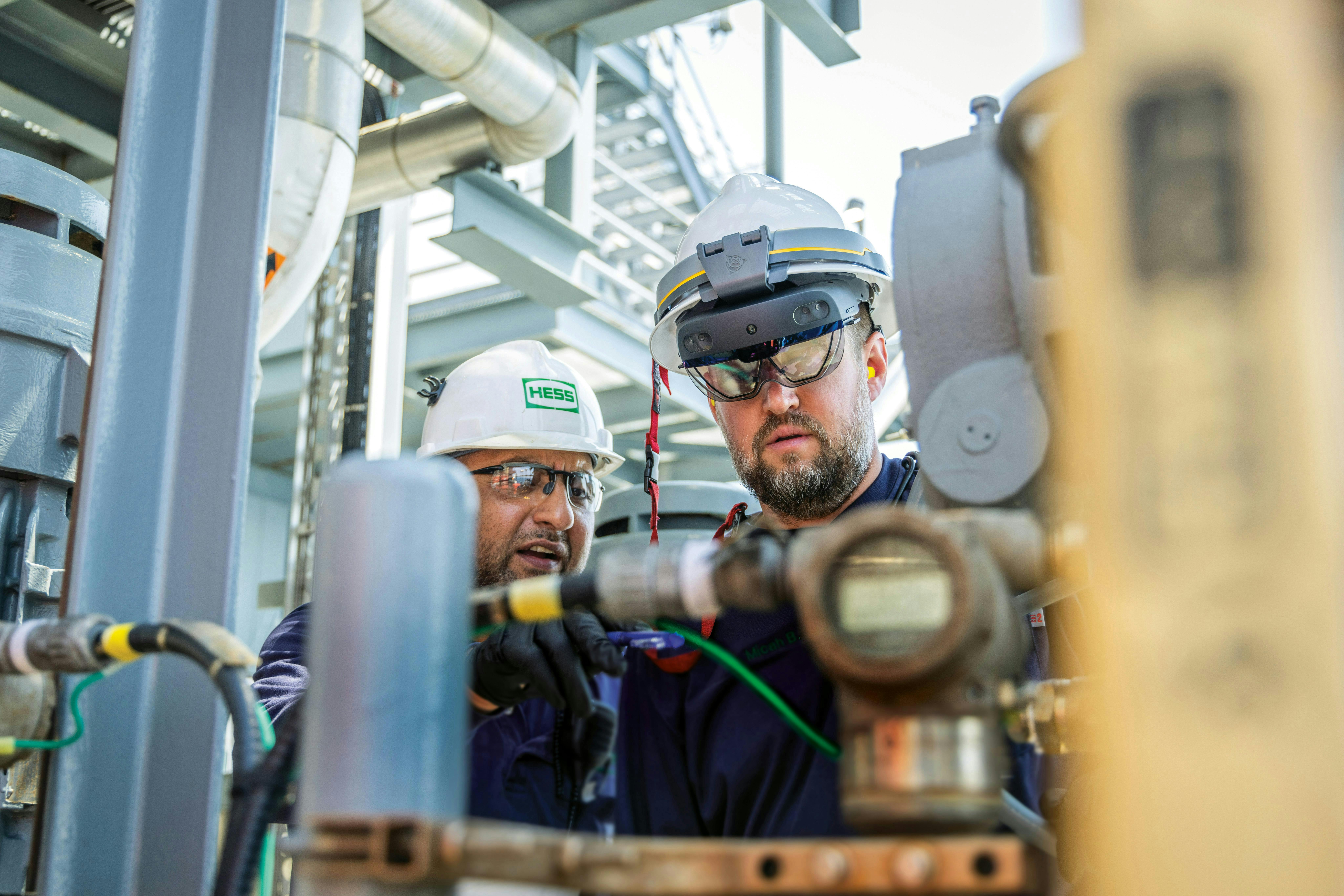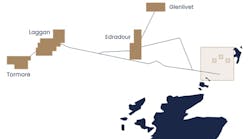Editor's note: This feature first appeared in the July/August 2024 issue of Offshore magazine.
By Jacob Vizinat and Jason Harry, Hess Corp.
Offshore operators are leaning forward on the promise of digital innovation to unlock a competitive edge that seeks to maximize value, optimize asset performance, and reduce impacts to the environment. Digital innovation is fueled by the power of contextualized data and the emergence of the Industrial Internet of Things (IIoT) to support advanced process automation, predictive maintenance, and artificial intelligence insights – wholly integrating operations with supply chains and logistics.
One example is remote inspections (through robotics) and advanced site surveillance which are automating routine integrity ‘find to fix’ workflows – reducing cost and streamlining mundane inspection tasks, mitigating risks in hazardous environments.
Digital twins and virtual reality simulations provide unprecedented insights into asset performance, reducing the need for short service personnel visits, inherently enhancing process safety.
Also, simplification and global optimization of simulation models (reservoir to sales) with physics-informed neural networks are guiding the quest for increased production capacities.
The future of offshore oil and gas operations will be characterized by enhanced productivity, cost-efficiency, and environmental sustainability, marking a paradigm shift to become more technologically sophisticated and resilient. The promise of digital is great; however, operators particularly have to lean in and simplify the collaboration landscape where innovation takes place.
Innovation moves faster than the speed of existing business processes. Digital innovators are quite frankly “the disruptors” to day-to-day workflows and corporate processes. The disruptor mentality is driven by the impending realization of Moore's Law (the doubling of computing power of IIoT devices every two years); that awareness underscores the urgency for testing offshore digital innovation through accelerated pilots to quickly unlock scaled competitive advantage. Navigating the currents of change must be facilitated by sped-up processes but must also protect operations from looming cybersecurity threats. Innovation (and disruption) of manual, tactical workflows require innovators to use a blend of human awareness and empathy as currency to support the change management journey. Digital implementation is far from linear; it navigates a highly nuanced landscape. There are intricate human elements and technological enablers that often prove to be the linchpin of innovation's success.
Data, connectivity
Data from multiple sources – sensors, drones, robotics, and field observations should be contextualized in a central data repository to extract meaningful insights. Advanced analytics further enable the extraction of actionable intelligence, empowering decision-makers to anticipate issues before they arise, enabling on-demand optimization. Collaboration between onshore and offshore teams is critical; therefore, efficient gathering and transmission of data back to shore is critical to feed real-time operations infrastructure that enable remote support. Offshore fiber optic is typically the best type of connection for latency and speed of data transmission. However, a combination of microwave, satellite, and LTE can offer an economical connectivity option. Nevertheless, robust cybersecurity measures, including encryption and access controls, must be in place to protect sensitive data. By investing in data, security and connectivity, offshore operators can unlock new opportunities for innovation.
Support organizations
Adapting existing support organization processes is essential for rapid prototyping and deploying new technologies. IT and OT pilots should initially focus on flexibility within a safe sandbox environment, allowing for experimentation without stringent certification standards. The sandbox should be simple yet secure, supporting a small group of test users. As R&D activities yield successful outcomes, the IT/OT focus should shift toward product hardening and compliance through scalability, cybersecurity, and a robust support model for a permanent solution.
Clear objectives and performance metrics must be outlined in pilot contracts, with the agility to accommodate adjustments and iterations based on outcomes. Positive pilot results should lead to increased structure as the project scales, requiring contracts to be revisited and refined to align with the expanded scope and requirements. These contracts should also include provisions for intellectual property rights, confidentiality, and dispute resolution mechanisms to protect interests and maintain trust among stakeholders.
Vendor ecosystem
While well-structured pilot contracts lay the foundation for scaling projects, the success of these initiatives also hinges on the proficiency and adaptability of innovation team members, as well as strategic collaborations with vendors. Innovation team members must be highly proficient, adaptable, and comfortable with a regularly shifting skill set to tackle ever-changing landscapes. Vendor reliance remains crucial for staying abreast of industry advancements and accessing specialized skill sets not available in-house for the typical operator. Change management and business integration are prime examples of innovation skills often not available in-house, necessitating collaboration with external experts who can align technological advancements with strategic objectives. Operators should be open to forming an internal ecosystem where multiple vendors contribute their unique domain expertise, allowing each to bring their "special sauce" to the table and collectively enrich the innovation process. The ecosystem approach proves successful, as many vendors offer point solutions without the domain knowledge and agility to address the specific needs of an operator’s digital innovation journey. Vendors should conduct preliminary assessments to understand their customer’s technology maturity level - evaluating underlying enablers like data architecture, connectivity, governance, etc. Vendors should not assume all data, cross-functional and human-related innovation barriers have been cleared; this ensures the proposed technology aligns with the customer's journey and maximizes successful adoption.
Offshore personnel
Offshore personnel face heightened risks and logistical complexities, which can impact their ability to embrace and adopt new technologies and processes. Offshore platforms typically involve a diverse workforce ranging from highly specialized craft workers to leadership which means effective communication and training programs are necessary to ensure understanding and buy-in for new initiatives. Leaders must navigate human factors by properly communicating how digital technology can simplify daily work to drive meaningful change in their operations.
Leveraging augmented reality
As part of Hess’ multiyear Autonomous Fields of the Future (AFoF) program, employees and contractors working onshore are collaborating with the company’s offshore operators using augmented reality (AR), an emerging technology that superimposes computer generated data such as text, images or video onto the real-world environment. The ongoing “Connected Worker” pilot is a part of the AFoF program. In the pilot, the offshore operators at one of the operator’s platforms are wearing AR headsets or smart glasses, giving specialists working onshore a shared “you see what I see” view of the platform and allowing for collaborative troubleshooting in real time. The use of these headsets eliminates the need for unscheduled offshore trips and in turn improves worker safety and reduces emissions, costs, and other impacts. The innovation and engineering teams are currently analyzing results from the pilot to determine additional use cases and to plan for making this new way of working available at other onshore and offshore facilities.
Fostering innovation
Forward-thinking leaders play a crucial role in fostering innovation culture by championing creativity, encouraging intellectual challenge to existing processes, and promoting cross-functional collaboration. They establish clear goals and priorities, providing the necessary resources and support to drive innovation. Leaders should cultivate an environment where failure is embraced as a learning opportunity rather than a setback, empowering employees to experiment and iterate on new ideas. Put simply, innovation should be treated differently and more agile by all parties involved.
Closeout
Digital innovation presents a transformative opportunity to enhance productivity, optimize assets, and ensure environmental sustainability. By establishing robust data and connectivity infrastructure, adapting support organization processes, leveraging the expertise of service partners and third-party vendors, and addressing the unique challenges faced by offshore personnel, the industry can navigate the complexities of technological change. Leadership plays a pivotal role in fostering a culture of innovation, encouraging collaboration, and guiding the organization through this dynamic landscape. As offshore operators continue to embrace digital advancements, they will unlock new levels of efficiency and resilience, paving the way for a more sustainable and competitive future in the energy sector.






